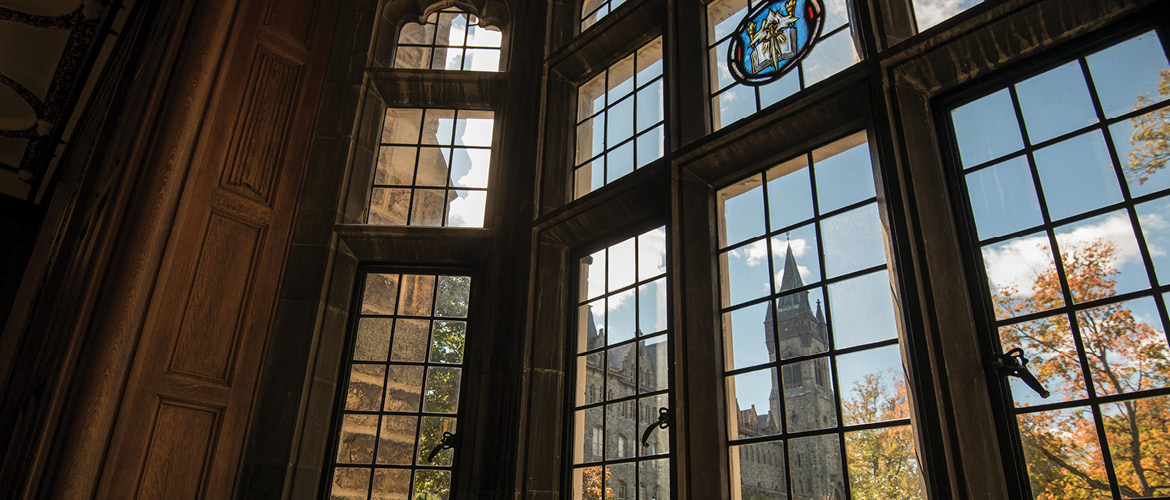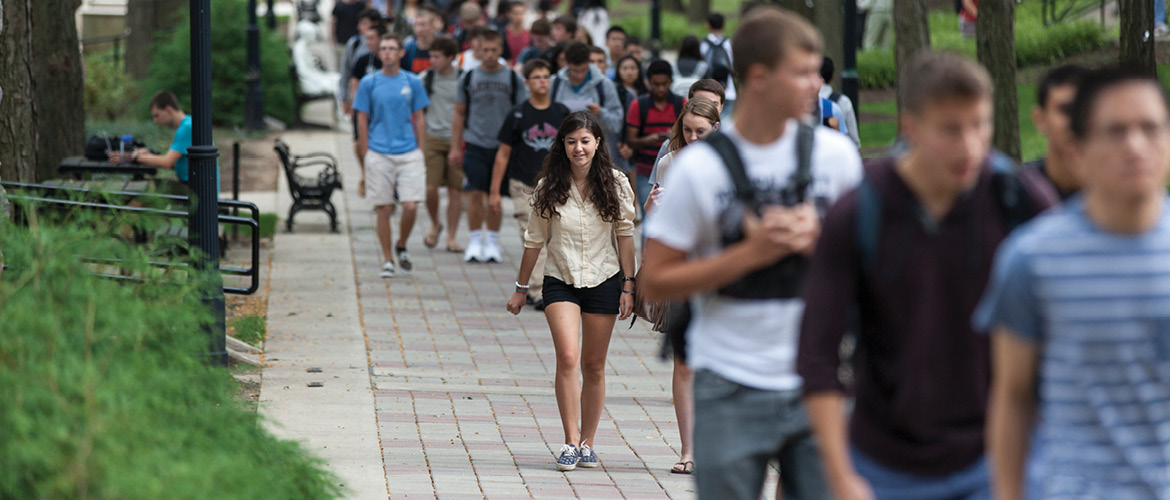President John Simon lays out an ambitious framework for the university’s future through undergraduate and graduate enrollment growth, faculty hiring, new academic programs and upgraded facilities.
WRITTEN BY
Editorial Staff
On the occasion of his first Founder’s Day as Lehigh’s president in 2015, John Simon spoke to the campus community about the importance of looking forward—and how the time had come to imagine a bolder, bigger future for Lehigh. He encouraged faculty, students, staff and alumni to participate in thoughtful, wide-ranging conversations about what that future might be, and how it might look. And he made the case that Lehigh stood at a crucial pivot point in its proud history—one that would ultimately determine the role it would play in a fast-changing and ever-more-complex world.
His core message that day was clear and simple: The time had come for Lehigh to take a great leap forward. Now, the university is prepared to do just that.
In early October, Simon presented to the university’s Board of Trustees the broad framework on which Lehigh’s future will be built. It is a vision that includes a series of sweeping, decisive steps that will see the university build on historic strengths and evolve into a more dynamic, impactful institution: an increase in both undergraduate and graduate enrollment, renovations to numerous campus buildings, the construction of new academic and residential facilities, the addition of 100 faculty and an expansion in the area of health that builds on the university’s existing strengths and current areas of expertise.
This framework was unanimously endorsed by the trustees, and elements of it are being shared by Simon with alumni as part of an ongoing series of “Imagine Lehigh” dinners. Meanwhile, the university leadership will begin implementing changes over the next few months that will catapult Lehigh forward and create a more impactful, dynamic institution.

“We are setting a direction that builds and expands upon our historic strengths and honors the core values that have made Lehigh such a special place,” Simon said. “This plan has the potential to be truly transformative for our university, and I could not have been more encouraged by the positive and enthusiastic response of our trustees, our faculty, our alumni and everyone in the campus community.”
“This is a truly extraordinary moment for Lehigh,” said Brad Scheler ’74 ’05P ’08P ’09PG, chair of the Lehigh Board of Trustees. “This plan charts a path to further distinction and expands opportunities for our already exceptional university. I am thrilled about the possibilities that lie ahead.”
Following the trustees meeting, Provost Pat Farrell shared details of this new vision for Lehigh here on campus, addressing the faculty during their October meeting. In an hour-long presentation that was received positively by the faculty community, Farrell detailed the multifaceted plan, which is an outgrowth of a series of World Café-style discussions with key constituencies across campus and with alumni and trustees. He outlined the specific ways in which the Lehigh community can begin to work in concert towards these broader goals.
Farrell said the 10-year framework relies upon foundational premises that need to be continuously evaluated and refined, and which leave room for development by others—particularly faculty—and also administrative and staff leaders. Indeed, Simon has noted that while the plan has many components—including a major focus on facilities and new construction—it is at its core an academic plan.
“In effect, our job is to prepare students for a future we never thought of.”
The goal, Simon says, is not growth alone; rather, it is to grow Lehigh in ways that serve to expand its capabilities and impact in teaching, learning and service. An expanded commitment to the growth of South Bethlehem and an even greater global engagement are also part of the new vision.
“All of these initiatives are things that we believe are crucially important as Lehigh strives to grow and expand upon its mission,” he said. “We really do believe the university stands at a crossroads, and we need to seize upon our many strengths to expand our capabilities in academics, in student life, in our engagement with Bethlehem and, truly, in everything else we do as well.”
From an academic point of view, Simon and Farrell say, Lehigh’s undergraduate program going forward must be broad, with significant depth in a variety of fields. Lehigh is known for its strong interdisciplinary programs, and going forward, those interdisciplinary perspectives need to be embedded in every major, minor and certificate program. This breadth of programs should create broad opportunities for collaboration, and the embrace of theory-to-practice should be a central part of academic endeavors.

Additionally, they note, professional graduate programs should serve those who aim for a specific profession, not necessarily a career in research.
Finally, research and graduate programs must be broad enough to engage faculty and students in each of the four colleges, yet flexible enough to create unexpected collaborations. Trained Ph.D. graduates should be able to go on to careers beyond academia. The addition of the 100 new faculty will bolster existing programs and help create new ones, fostering an even more dynamic culture of discovery.
Chris Brezski ’97 attended an “Imagine Lehigh” dinner in Boston. “Expanding the university should prove a benefit with more diverse opportunities, a larger alumni network and ultimately greater resources,” he said.
As part of the initiative, Lehigh will continue efforts to generally increase diversity across constituencies (undergraduate students, staff and faculty), while at the same time increasing the undergraduate graduation rate to 90 percent or more and attracting a diverse group of talented students from a broader geographic base. Simon believes that last element is crucial, as an expanded focus for student recruitment would bring not only new perspectives to campus, but help improve Lehigh’s reputation nationally as well.
Lehigh will continue to develop a robust range of undergraduate programs, with a goal of attracting and educating a diverse group of students for career-start and long-term success; being conscientiously and recognizably interdisciplinary in our approach; thoroughly incorporating a global attitude and experience; adopting a more outcomes-focused view; and retaining the ethos of putting theory to use.
“We are setting a direction that builds and expands upon our historic strengths and honors the core values that have made Lehigh such a special place.”
“In effect,” Farrell said, “our job is to prepare students for a future we never thought of.”
To fully realize these academic goals, Farrell stressed that full support for students is critical. This could include academic support, advising and physical and mental health efforts. This support will become even more important as the student body becomes more geographically, culturally and ethnically diverse.
For faculty, the new plan also places a strong emphasis on research and scholarship.
Farrell said it will be an expectation that all faculty are actively engaged in research and scholarship, and that institutional support will go to areas that are most likely to achieve the overarching goals of knowledge creation, graduate student development and national prominence.
“Many of these will fall between conventional disciplines,” he said. “They may not even be accepted as ‘real research’ for some time. We might want to think a little bit differently about these.”
Simon says it’s important to note that the identification of bolder university goals does not in any way conflict with the university’s great traditions, proud heritage or well-established strengths. Rather, this pivot point in Lehigh’s history is one that merely builds on all that has been accomplished and built before.
“For me, moving Lehigh forward is about taking the core values of the institution and making them operational in the context of our current times,” he explained. “That impacts student life, it impacts academics, it impacts our connections to industry and impacts how we are going to position ourselves nationally. We’ve always had a very practically focused education here—that would be my sense after a year here, and there’s nothing wrong with that. But the question is how you bring that institutional culture into this decade.”
Both Simon and Farrell say they recognize the potential for growing pains as the plan is implemented, acknowledging the consequences of a more dynamic institutional environment. Though possibly unsettling, this level of change also presents enormous opportunity, they said.
“I have a deep confidence and belief in Lehigh’s future,” Simon says. “Our challenge now is to step boldly, together, into that future.” ●